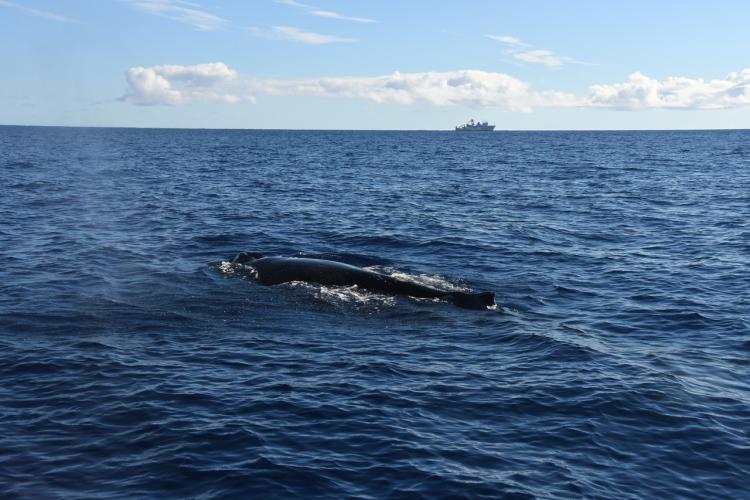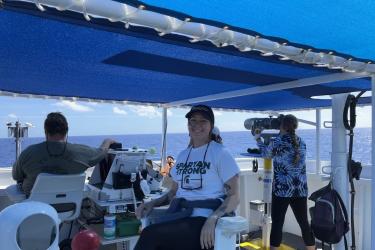The 2020 Winter Hawaiian Islands Cetacean and Ecosystem Assessment Survey, or "WHICEAS," is a survey for cetaceans (whales and dolphins) and seabirds around the main Hawaiian Islands during the winter season. From mid-January to mid-March, we will conduct visual observations to estimate group size, photograph individuals, collect biopsy samples, and deploy satellite tags; and record cetacean vocalizations with a towed hydrophone array, sonobuoys, and drifting acoustic recorders.
Humpbacks Sighted Near Niʻihau

The project begins with many sightings of humpback whales in waters north of Kauaʻi and Niʻihau. Here's a humpback whale in waters northwest of Niʻihau on January 21, 2020, with the NOAA Ship Oscar Elton Sette in the distance. Photo: NOAA Fisheries/Andrea Bendlin.
First Small Boat Operations of the Season

Beautiful weather conditions enabled us to launch the small boat where we have a chance to take identification photos, collect biopsy samples, or deploy satellite tags. The small boat crew returns with big smiles after a successful afternoon working around humpback whales and bottlenose dolphins. Photo: NOAA Fisheries/Allan Ligon.
Evening DASBR Prep for Early Morning Deployment

In addition to standard visual and acoustic operations, we will deploy a handful of stand-alone acoustic buoys that drift with the current—we call these instruments drifting acoustic spar buoy recorders (DASBRs). Our team gets the next DASBR unit ready on the evening before an early morning deployment. After a few weeks, the ship will locate this DASBR and retrieve it so we can download its data. Photo: NOAA Fisheries/Suzanne Yin.
Retrieving a DASBR After 4 Days Adrift

Lead Fisherman, Mills Dunlap, retrieves a DASBR that was deployed in deep water 4 days ago. The biggest benefit we get from DASBRs are the acoustic data they collect independently from the ship. This way, we can collect data and avoid disturbing our subjects. Photo: NOAA Fisheries/Suzanne Yin.
Laysan Albatross in the Breeze

After wandering the North Pacific Basin during the summer months, Laysan albatross are returning to their Hawaiian nesting islands. Photo: NOAA Fisheries/Michael Force.
Kilauea Lighthouse from the Sea

Kilauea Lighthouse, Kauaʻi, as seen from the Oscar Elton Sette. Photo: NOAA Fisheries/Christopher Hoefer.
A Quick Fly-by

A curious white-tailed tropicbird does a "fly-by" over the Sette. Tropicbird tails can be up to 18 inches long! Photo: NOAA Fisheries/Michael Force.
Sei Whale Sightings!

Sei whales are baleen whales ranging from 45 to 60 feet long. We have already seen multiple sei whales on WHICEAS, which is much more than expected given low sighting numbers on previous Hawaiian Islands surveys. Photo: NOAA Fisheries/Christopher Hoefer.
"Jack Staff for Two, Please!"

One of a pair of brown boobies who took residence on the ship's jack staff today. In addition to catching flying fish and painting the bow white, the birds spent the day squabbling at each other. The females have characteristic “honking” calls, while the male call is a high-pitched whistle. Photo: NOAA Fisheries/Christopher Hoefer.
Deploying the Enhanced DASBR Unit (a.k.a. the "DASBR+")

The acoustics and deck crews deploy a DASBR+ that our science operations team helped fabricate. This DASBR includes lights and an automatic identification system for improved nighttime retrieval. Photo: NOAA Fisheries.
Putting on a Show

Rough-toothed dolphins swim circles around a group of humpback whales near Penguin Bank. Photo: NOAA Fisheries/Andrea Bendlin.
Inspect a Gumby, Save a Life!

Ensigns Moore and Park check the condition of survival suits (a.k.a. "gumby suits") before a weekly abandon ship drill. Photo: NOAA Fisheries/Suzanne Yin.
"Mom, Why Isn't This Working?"

A sperm whale calf breaches, showing us it has several remoras on its body. Calves often appear to have more remoras than adults, maybe because they cannot dive as deep as adults. This calf may be attempting to dislodge the remoras. Photo: NOAA Fisheries/Andrea Bendlin.
An Extremely Joyful and Relieved Acoustics Team

Since 2017, we have deployed 45 drifting acoustic recorders (DASBRs) and five were lost at sea. One of them stopped transmitting during this project, and the acoustics team didn't expect to find it without its location beacon. But thanks to a search pattern designed by Ensign Park and the excellent eyes of our visual observer team, we were able to find and recover this one. Photo: NOAA Fisheries/Suzanne Yin.
A Welcomed Encounter

We rarely see Fraser's dolphins. Some of our observers have sailed for years without seeing them! This photo shows one adult male (dark stripe) with several subadults. Photo: NOAA Fisheries/Allan Ligon.
Gotcha!

The saying goes, "there are plenty of fish in the sea." Well, thanks to the deft hunting skills of this red-footed booby, now there is one less fish in the sea. Of the three species of boobies in Hawai'i, this species specializes in aerial pursuit—snatching the fish right out of the air! The chase is spectacular, with the bird nimbly juggling the fish to swallow it head-first. Photo: NOAA Fisheries/Michael Force.
The Moon in its Full Glory

Though primarily used to search for cetaceans, the "Big Eye" binoculars occasionally come in handy for full-moon viewing! Photo: NOAA Fisheries/Suzanne Yin.
Halfway Point

Our project has reached its halfway point. The Sette returned to Honolulu on Wednesday, February 12th to resupply and give the crew some downtime. The Sette returned to sea on Monday, February 17th to continue the survey. Photo: NOAA Fisheries/Kymberly Yano.
A Friendly Greeting

This Laysan albatross was seen catching a draft off the ship. Photo: NOAA Fisheries/Marie Hill.
Recovering Equipment with 2 Years of Acoustic Recordings and Deploying Equipment for New Data

The entire Sette deck crew recovered a listening station device for the Pacific Marine Environmental Laboratory that we deployed in July 2017 during HICEAS. They then lowered a new recording device into the water for deployment. Photo: NOAA Fisheries/Marie Hill.
Simple Elegance

The red-tailed tropicbird is one of three species of tropicbirds throughout the world’s tropical oceans. They feed primarily on flying fish, making spectacular plunges into the sea, often from extreme heights above the ocean. All three species have specialized central tail feathers longer than their other feathers. The deep carmine red tail streamers of the red-tailed tropicbird were highly coveted by many south Pacific cultures. Photo: NOAA Fisheries/Michael Force.
Fashionably Late Party Guests

Unexpectedly, we saw our first pilot whales for WHICEAS 2020. We normally encounter them often. Pilot whales are one of the biggest of the dolphin family, have blunt heads, are deep divers, and often feed on squid. Photo: NOAA Fisheries/Christopher Hoefer.
Distinct Rostrums

Rough-toothed dolphins are fairly common around the Hawaiian Islands, and are distinguished by their reptilian-like heads. Photo: NOAA Fisheries/Andrea Bendlin.
The Beloved Gentle Giants of Hawaiʻi

Humpback whales remain one of our most commonly sighted species during this expedition, making up over 50 percent of our sightings so far. Photo: NOAA Fisheries/Marie Hill.
A Pelagic Sandpiper

Few are aware of the existence of a pelagic (open ocean) sandpiper. The red phalarope nests in the Arctic and spends the rest of its life at sea, often hundreds of nautical miles from shore. They are regular but uncommon winter visitors to Hawaii; few have been photographed at sea in the state. Their toes are unique for sandpipers by being lobed, allowing them to swim with ease. Photo: NOAA Fisheries/Michael Force.
Welcome to Our Office

The marine mammal and seabird observers spend sunrise to sunset on the Sette's flying bridge, searching for cetaceans and seabirds. Today, they are enjoying the beautiful weather conditions off the west side of Hawai'i Island. Photo: NOAA Fisheries/Marie Hill.
A Beautiful Day for HARP Operations

We maintain a long-term dataset of recordings collected from high-frequency acoustic recording packages (HARPs) at 13 different sites around the world. One site includes a HARP located offshore from Kona, Hawai'i Island. Today, the acoustics team led the effort to recover the "old" HARP with data (top) then redeploy a "new" HARP with an empty hard drive to record new acoustic data (bottom). Photo: NOAA Fisheries/Marie Hill and Suzanne Yin.
Rain Squalls Create Vibrant Rainbows

Beautiful Hawaiian rainbow after passing through a rain squall. Photo: NOAA Fisheries/Suzanne Yin.
Are you a Hawai'i Resident?

A melon-headed whale (Peponocephala electra) porpoises out of the water. Melon-headed whale group sizes can range from 30 to over 1,000 individuals. There is a resident group off Hawai'i Island, and we will use dorsal fin photo ID to help determine if this individual is a resident. Photo: NOAA Fisheries/Suzanne Yin.
"The Way to Someone's Heart is Through Their Stomach"

It takes many people aboard the Sette to make WHICEAS a success, and one of the hardest crews work in the galley. Stewards Chris Williams, Patrick Fennell, and Susan Swartz work all day to keep our crew happy and fed! Photo: NOAA Fisheries/Suzanne Yin.
Pakani Nui Wind Farm

Pakani Nui Wind Farm seen from offshore near South Point on Hawai'i Island. Clean energy is an increasingly important way that our island communities generate power. One of our main funders for this WHICEAS cruise is the Bureau of Ocean Energy Management (BOEM), and they are very interested in developing projects for renewable energy. Photo: NOAA Fisheries/Suzanne Yin.
The View during "Weather Watch"

Strong winter winds can make for challenging survey conditions. This day was particularly rough, with sustained winds over 30 kt. In conditions like this, the mammal observers go on "weather watch," where a single observer watches to see if conditions improve. Video: NOAA Fisheries/Allan Ligon.
Seabird Photo Quiz Time!

Two birds. One species. What is it?
First clue: they are common around Hawaiʻi.
Second clue: they frequently ride the updraft in front of the Oscar Elton Sette and feed on flying fish flushed by the ship.
Bonus clue: they have red feet.
Answer? Post your guess on Twitter!
Photo: NOAA Fisheries/Michael Force.
Adding Ears to the CTD Rosette

The Sette decided to conduct a conductivity, temperature, and depth (CTD) cast over Cross Seamount to collect environmental DNA (eDNA) of our elusive "Cross Seamount beaked whale." This whale has a vocalization pattern that's often heard at Cross Seamount at night. But we need a near-simultaneous acoustic detection and visual sighting to identify its species, so Erik Norris and Jennifer McCullough have attached an acoustic recorder to the CTD rossette. Photo: NOAA Fisheries/Marie Hill.
Collecting Water Samples at Specific Depths

The Sette's Survey Tech, Steve Eykelhoff, monitors the CTD rossette as it descends to 1,000 m. He triggers the bottles to collect water at specific depths during the ascent back to the surface. Photo: NOAA Fisheries/Jennifer McCullough.
Filtering CTD Water Samples to Collect eDNA

Marie Hill and Ann Allen filter water samples at Cross Seamount to collect environmental DNA (eDNA) samples. If a Cross Seamount beaked whale vocalized during the CTD cast, then we will send these samples to Oregon State University's genetics lab for species identification. Photo: NOAA Fisheries/Jennifer McCullough.
A Gorgeous International Visitor

The Nazca booby breeds in the eastern tropical Pacific Ocean, primarily on the Galapagos Islands. It is a rare visitor to Hawaii. This is our first sighting during this expedition. We also saw one during HICEAS 2017. Its pinkish-orange bill distinguishes it from the common and widespread masked booby, which has a yellowish bill. Photo: NOAA Fisheries/Michael Force.
A Light Morph of the Kermadec Petrel

A light morph Kermadec petrel swoops down the face of a breaking swell in a 33-knot, Beaufort 7 sea. These masters of the air are completely at ease in conditions that can halt our visual survey effort. This species is polymorphic, meaning there are different color types. The species visits Hawaii primarily in winter, and has been seen inspecting potential nest sites at Kilauea Point, Kauai. Photo: NOAA Fisheries/Michael Force.
Squid Acrobatics

A school of flying squid scatter from the wake of the ship. Photo: NOAA Fisheries/Christopher Hoefer.
"A Hui Hou" (Until We Meet Again in Hawaiian)

A humpback whale and a rough-toothed dolphin simultaneously show their flukes (tails) for a picture-perfect moment to celebrate the end of another successful project. Photo: NOAA Fisheries/Andrea Bendlin.

